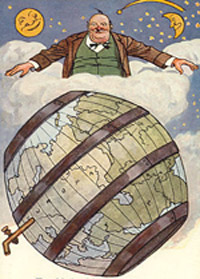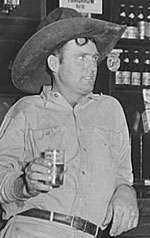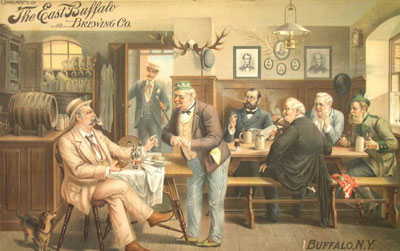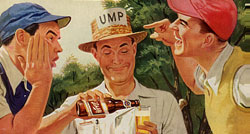A couple of years ago Boston Beer founder Jim Koch was talking about innovative beers.
“. . .(A) product has to be truly superior and good on its own,” he said, later adding, “We’re not trying to make a pet rock of beer, but new styles that are cherished 100 years from now.”
He made a similar point a few minutes later. “It can’t just be a marketing gimmick. It has to be rooted in product difference. Typically, it’s not just better, but uniquely so,” he said.
 I thought of that conversation when we were talking about the new tasting glass commissioned for Samuel Adams Boston Lager. To introduce the glass to the press the company sent out a package with two bottles of beer, a Samuel Adams branded shaker glass and the new Samuel Adams Boston Lager glass. It was no contest, but other than the spill factor, pouring Boston Lager into cupped hands might also have been better than a shaker glass.
I thought of that conversation when we were talking about the new tasting glass commissioned for Samuel Adams Boston Lager. To introduce the glass to the press the company sent out a package with two bottles of beer, a Samuel Adams branded shaker glass and the new Samuel Adams Boston Lager glass. It was no contest, but other than the spill factor, pouring Boston Lager into cupped hands might also have been better than a shaker glass.
Is this glass not only better, but markedly so? In fact, I think so, but we’ll get to that.
Koch said that Boston Beer spent several hundred thousand dollars developing the glass. (The details are here.)
“This had to be a legitimate, bona fide, verifiable improvement,” he said. “So much of this can be smoke and mirrors.”
By the 1700s “the proper glass” began to take on meaning with wine drinking types (in other words, all “proper society”), and by the 1800s each type of wine was to have its own glass. For purposes of form, not function.
Thus Champagne was poured in a coupe – a shallow, wide-mouthed glass – although it was the perfectly wrong vessel. Even today, when we know a flute best serves Champagne, you still see it served in coupes because that’s the way it is pictured in somebody book of etiquette.
Just a generation ago American wine drinkers didn’t pay that much attention to glassware, but producers – most notably Austria’s Riedel – have done a great job of convincing drinkers they need a different glass for every style of wine. To persuade us, Riedel promoted the so-called “tongue map,” which is about 100 years out of date.
So Koch approached the project with a proper amount of beer drinkers’ skepticism.
“I wanted this to be rooted in science,” he said. He turned to Tiax, a Boston-area company that’s been combining technology and sensory testing since the 1920s.
“Jim’s approach was unique,” said Jonaki Egenolf, manager for technology marketing at Tiax. “He really wanted true objective analysis. That was different than just trying to leverage expertise within the industry.”
Sarah Garretson Lowery, the sensory analyst for the project, added, “It was unique to see somebody who wasn’t new to an industry come in with such a fresh eye.”
A blogger for Food & Wine magazine wrote the resulting glass looks “like the offspring of a lantern and a goblet, with a narrow base, bulbous center and outward-turned lip-like a translucent Alfred Hitchcock, I guess.”
But that outward turned lip (see the illustration) really seems to work, and the glass persistently delivers great aromatics (so credit that funny bulbous middle).
Koch has found the perfect line – “PBR (Pabst Blue Ribbon) is not going to taste like Sam Adams in this glass” – to make his point that this glass is designed to make Boston Lager taste better, not with other beers in mind. But that doesn’t mean we can’t take a few other beers for a test run.
I did. Ales and lagers. Hoppy beers and not. Some were a little better, some significantly better. Of course, I often could have done just as well with another glass from the cabinet.
And not every beer tasted better. I tried an India Pale Ale that I previously found not particularly well balanced. It was worse. The hops were harsher and even more out of balance.
I didn’t try PBR. There’s only so much I’m willing to do in the name of science.
 Where is the center of the beer universe?
Where is the center of the beer universe? In the course of the conversation that sprung from my post about a review of
In the course of the conversation that sprung from my post about a review of 

 I thought of that conversation when we were talking about the new tasting glass commissioned for Samuel Adams Boston Lager. To introduce the glass to the press the company sent out a package with two bottles of beer, a Samuel Adams branded shaker glass and the new Samuel Adams Boston Lager glass. It was no contest, but other than the spill factor, pouring Boston Lager into cupped hands might also have been better than a shaker glass.
I thought of that conversation when we were talking about the new tasting glass commissioned for Samuel Adams Boston Lager. To introduce the glass to the press the company sent out a package with two bottles of beer, a Samuel Adams branded shaker glass and the new Samuel Adams Boston Lager glass. It was no contest, but other than the spill factor, pouring Boston Lager into cupped hands might also have been better than a shaker glass.